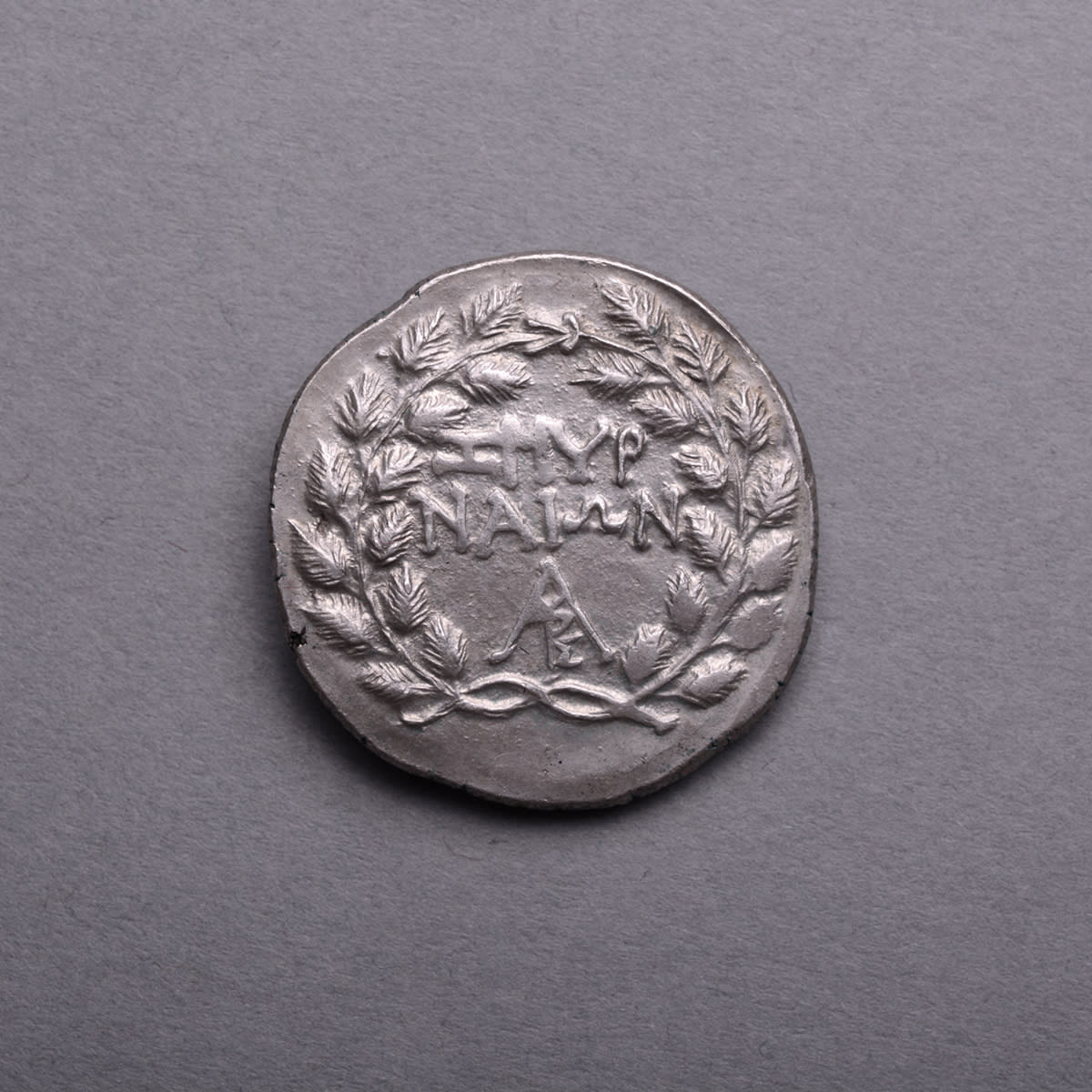Ionian Silver Tetradrachm of Smyrna, 160 BCE
Silver
C.4137
Obverse: Turreted Head of Tyche Facing Righ Reverse: Legend 'SMYRNAIWN' and Monogram Encircled by Wreat Due to its strategic location on the Aegean coast of Asia Minor and its connections...
Obverse: Turreted Head of Tyche Facing Righ
Reverse: Legend "SMYRNAIWN" and Monogram Encircled by Wreat
Due to its strategic location on the Aegean coast of Asia Minor and its connections with the interior, the ancient city of Smyrna (modern Izmir, Turkey) was an important center of trade and remains so today. The city was originally founded by Greek colonists and soon rose to prominence, becoming one of the leading city-states of Ionia. The rise of the Lydians in the 7th century B.C. imperiled the fortunes of the city. Although Smyrna was able to hold out for several decades, it was eventually conquered and sacked by the forces of King Alyattes II and the Greek culture of the city was ostensibly supplanted. Legend has it that Alexander the Great decided to rebuild the Greek city, albeit in a nearby location from the ruins of the ancient city. However, it was not until the reigns of his followers Antigonus and Lysimachus that his plans were actually carried out and Smyrna again prospered. At the beginning of the 2nd century B.C., Smyrna cut ties with the Attalid kings of Pergamum and allied themselves with the Romans. By the time the last Attalid king Eumenes III dies without an heir, the Romans gained control of all their possessions, including Smyrna. Under Roman domination, Smyrna remained one the principal cities of Asia Minor.
How many hands have touched a coin in your pocket or your purse? What eras and lands have the coin traversed on its journey into our possession? As we reach into our pockets to pull out some change, we rarely hesitate to think of who touched the coin before us, or where the coin will venture to after us. More than money, coins are a symbol of the state that struck them, of a specific time and place, whether currency in the age we live or an artifact of a long forgotten empire. This ancient coin is more than an artifact; it is a memorial to the glories of an ancient city passed from the hands of civilization to civilization, from generation to generation.
Reverse: Legend "SMYRNAIWN" and Monogram Encircled by Wreat
Due to its strategic location on the Aegean coast of Asia Minor and its connections with the interior, the ancient city of Smyrna (modern Izmir, Turkey) was an important center of trade and remains so today. The city was originally founded by Greek colonists and soon rose to prominence, becoming one of the leading city-states of Ionia. The rise of the Lydians in the 7th century B.C. imperiled the fortunes of the city. Although Smyrna was able to hold out for several decades, it was eventually conquered and sacked by the forces of King Alyattes II and the Greek culture of the city was ostensibly supplanted. Legend has it that Alexander the Great decided to rebuild the Greek city, albeit in a nearby location from the ruins of the ancient city. However, it was not until the reigns of his followers Antigonus and Lysimachus that his plans were actually carried out and Smyrna again prospered. At the beginning of the 2nd century B.C., Smyrna cut ties with the Attalid kings of Pergamum and allied themselves with the Romans. By the time the last Attalid king Eumenes III dies without an heir, the Romans gained control of all their possessions, including Smyrna. Under Roman domination, Smyrna remained one the principal cities of Asia Minor.
How many hands have touched a coin in your pocket or your purse? What eras and lands have the coin traversed on its journey into our possession? As we reach into our pockets to pull out some change, we rarely hesitate to think of who touched the coin before us, or where the coin will venture to after us. More than money, coins are a symbol of the state that struck them, of a specific time and place, whether currency in the age we live or an artifact of a long forgotten empire. This ancient coin is more than an artifact; it is a memorial to the glories of an ancient city passed from the hands of civilization to civilization, from generation to generation.



